Four years of background research and two years of carefully documented shovel test pits finally came to fruition on August 1, 2019.
The first two buckets from Shovel Test Pit (STP) 6 yielded a dozen or so chert flakes. Then in that next bucket – pay dirt!!!
On top of the loose soil and hunks of spalled sandstone sat a beautifully crafted rhyolite Susquehanna Broadspear! In an instant I’d found what was needed to back up years of work.
I immediately texted a photo of the find to Hannah Harvey at the PA SHPO and within days had a site number. Alpenglow Rockshelter, 36LU0349, can now take its official name and move forward into the next phase of study on Council Rock Mountain.
This small mountain, situated east of the Wyoming Valley in Northeastern PA, is so rich with potential – and virtually untouched.
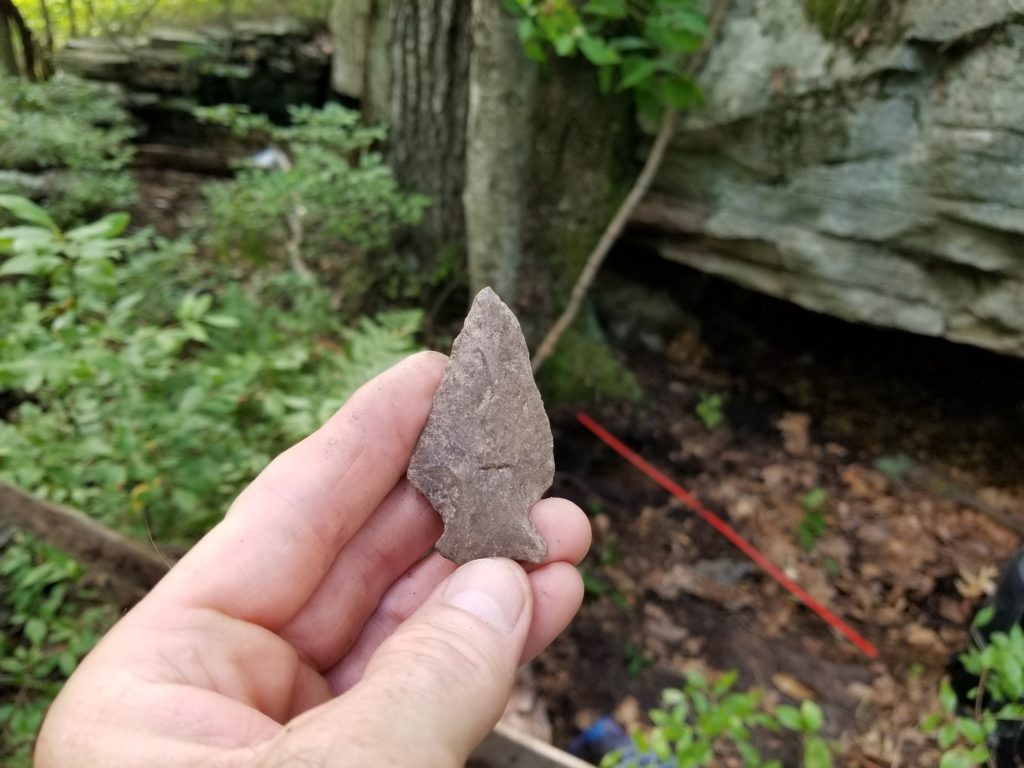
First Noticed in 2008
This slender rockshelter first caught my eye in 2008.
Its opening is currently only 50 cm high, 2 meters back, and 15 meters long at the western end of a 50 meter long meta-sandstone (sandstone that has undergone change due to heat/pressure) ridge. A vernal pool sits at the upper (eastern) end of a valley parallel to the rockshelter, and a continuously running spring emerges 50 meters west. The rockshelter faces due south. This combination of indicators has always made it a perfect candidate for field work. Unfortunately, when I found it in 2008 I was busy with other things.
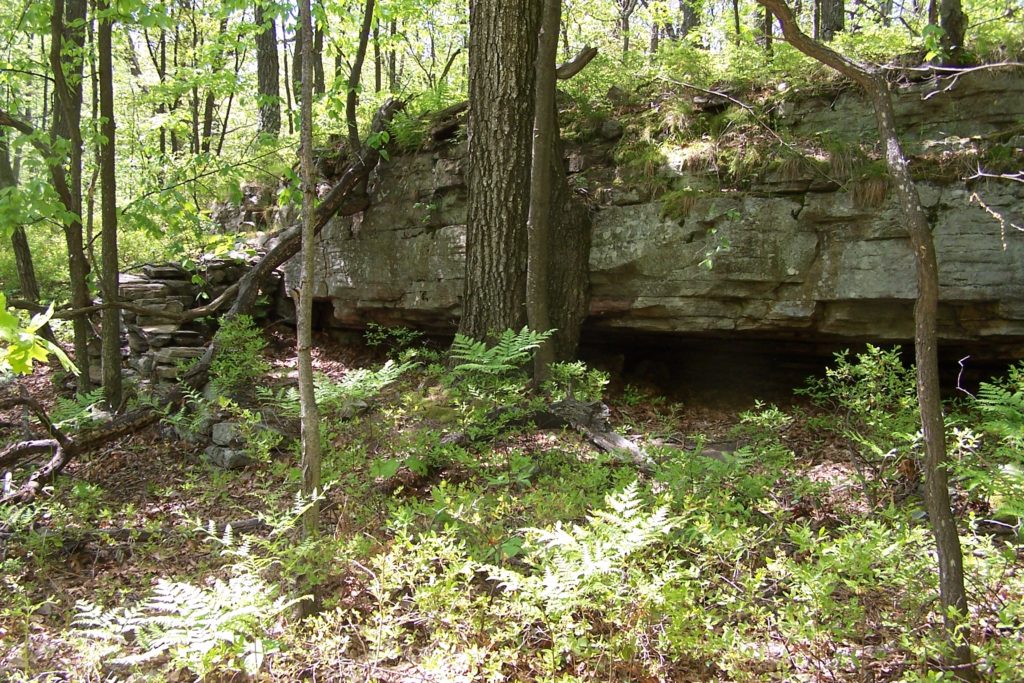
The Council Rocks site – 36LU0306
The nearby Council Rocks site, a still controversial archaeoastronomy site, sits about 200 meters east. It’s been registered with the PA SHPO since 2011 as 36LU0306.
I thank the Society for Pennsylvania Archaeology (SPA), and the PA SHPO for helping this not-yet-avocational archaeologist so long ago!
It was in the fall of 2007 that my love of astronomy and affinity for hiking led to a realization of the significance of four oddly shaped 20-ton boulders on a hilltop meadow.
From then through 2015 and with the help of seasoned academics in several states and countries, I’ve been able to carefully research and credibly document the likely purpose and significance of this 4,000-year-old ceremonial site.
Acceptance of such a site in this country is still a bit challenging, yet I’m sure its compelling features and ideal setting will increasingly attract academic recognition.
I’ve given presentations to receptive audiences in many states, most recently in Michigan and Virginia, and had been invited to present at a SEAC (European Society for Astronomy in Culture) event in the United Kingdom in 2016.
I’ve also had the pleasure and honor of presenting at many SPA meetings. It was this ongoing work with Council Rocks that led me to put the rockshelter on hold until 2015.
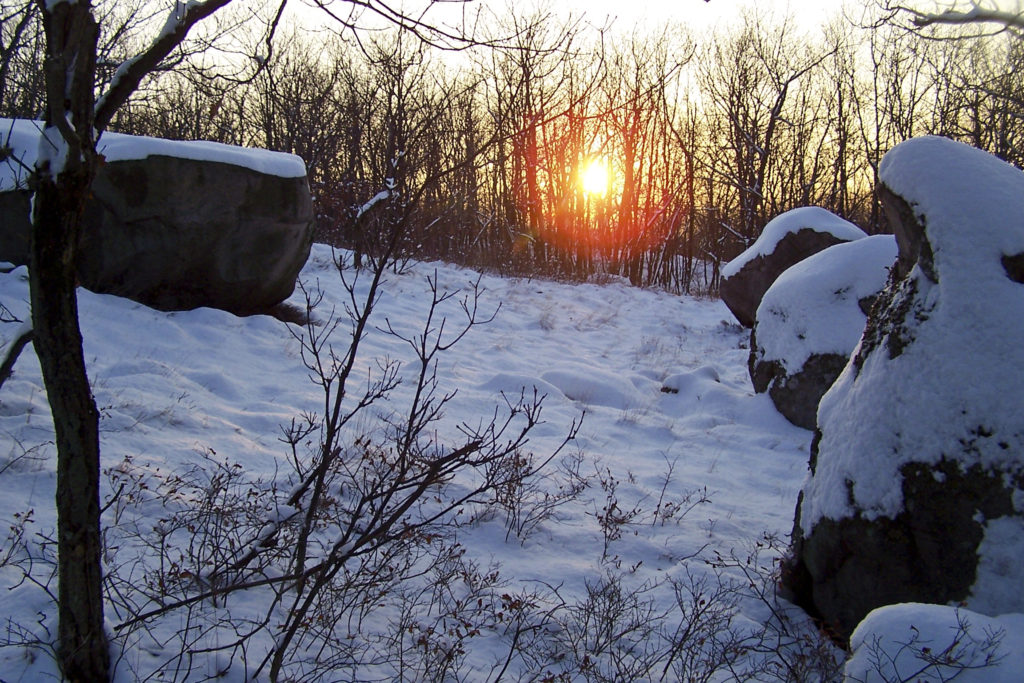
Rockshelter under serious study since 2015
In 2015, I had an inspiration to measure the slope of the bedrock covering most of this mountain and compare it to the unusually level surface in the valley adjacent to the rockshelter.
My partner Carla helped record surface elevations in a 12 x 12 meter grid which were then used to construct a 3D model of the valley floor adjacent to the rockshelter. From this it appeared that the rockshelter, currently open by 50 cm, may have been 4 to 6 meters deep at the time the glaciers receded 12,000 years ago.
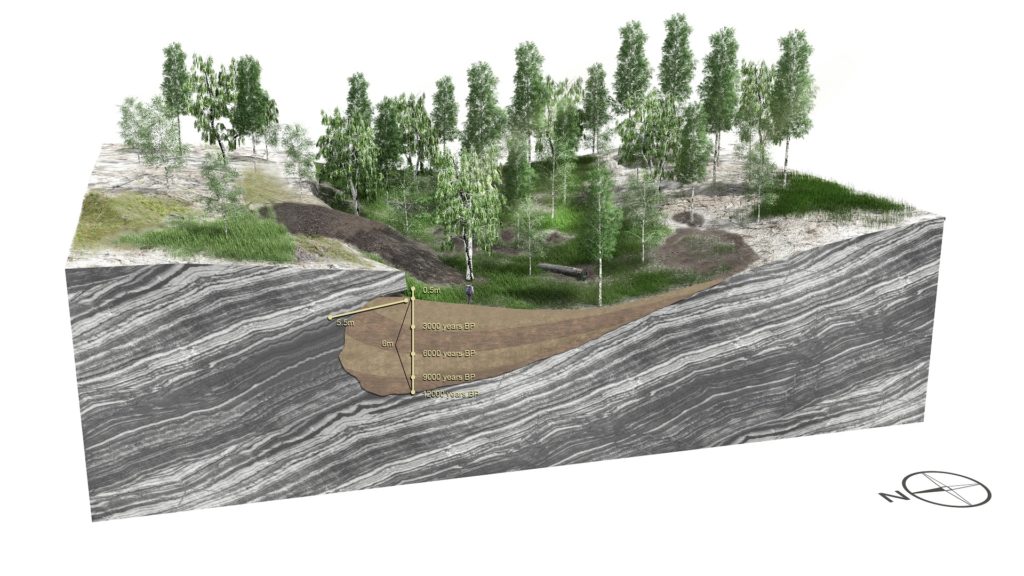
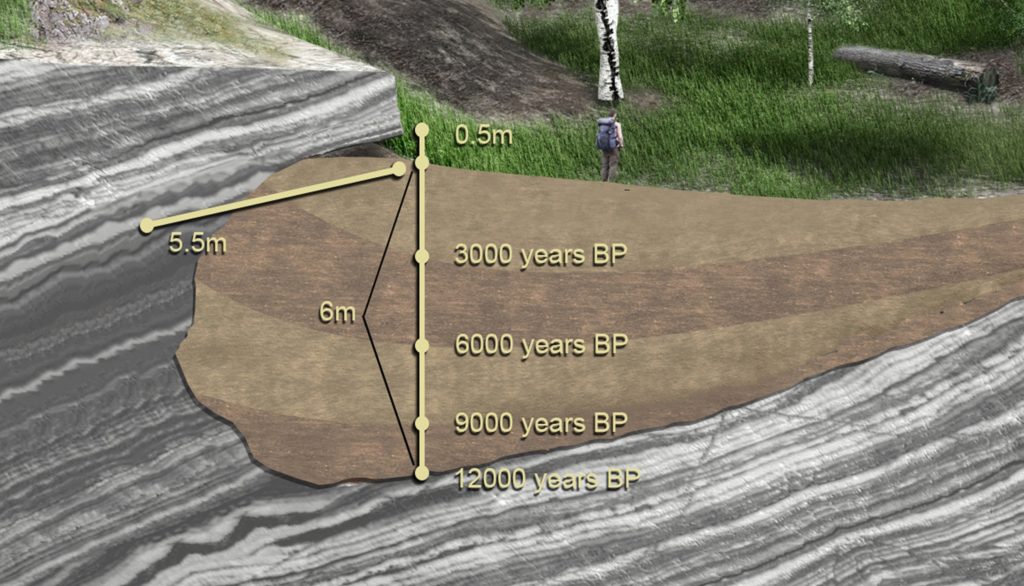
While presenting on this theory at the SPA Annual Meeting in Bethlehem that year, I met Dr. George M. Leader, a visiting scholar at the University of Pennsylvania.
Dr. Leader visited the site later that year and suggested I start digging STP’s to look for evidence of occupation. Planning and excavating began the following year.
By mid 2018, I had what I felt was a good collection of evidence to register the site: STP 1 revealed the perimeter of a possible fire pit at 40 cm, STP 3 had scattered pockets of charcoal, and STP 4 yielded several likely manuports.
I chose to file the PASS report in July of 2018.
Naming the Site
I also needed to come up with a name for the site. My partner Carla and I had gone to Maryland in 2015 to see one of her favorite bands, a progressive rock group from Finland called ‘Nightwish’. They had just released their latest album “Endless Forms Most Beautiful” with songs linked to science as a path to understanding.
The ninth cut ‘Alpenglow’ has the recurring theme of “We Were Here…”, lyrically describing people who have come before, passed on, and have once again become part of the landscape. I decided this theme would fit perfectly!
So when we saw the band again in 2018 I asked their permission to name the site “Alpenglow”. Of course, they were all delighted and eagerly autographed my Pennsylvania Archaeological Site Survey (PASS) report!
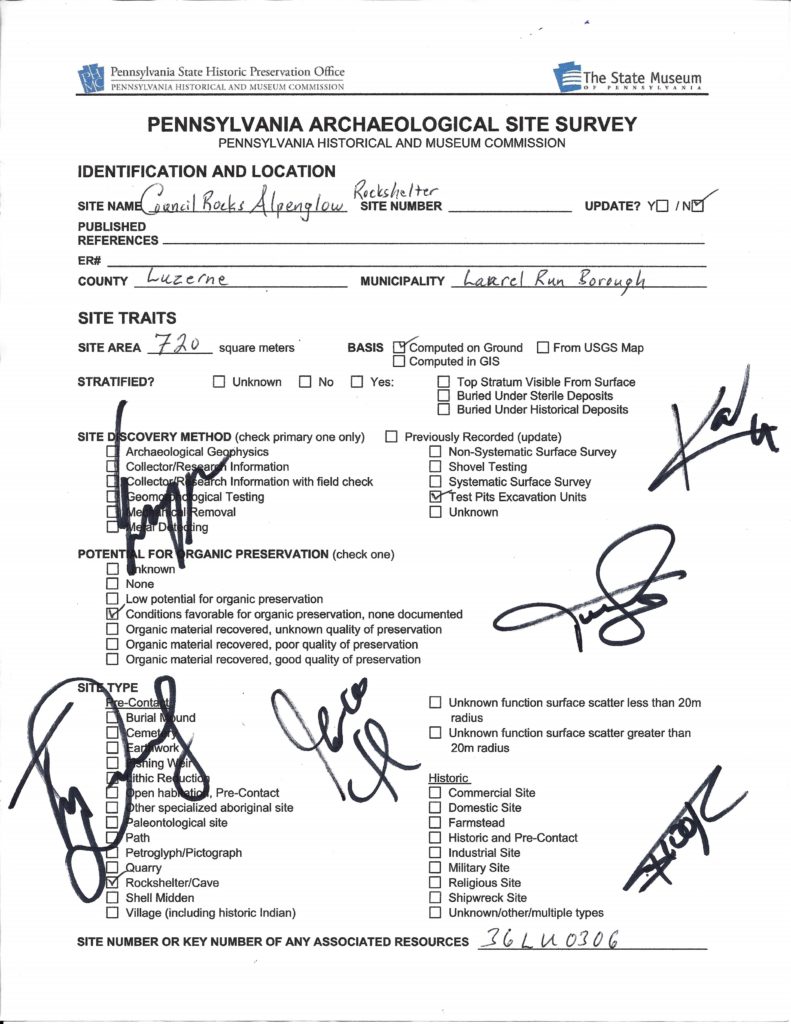
Unfortunately, the report was not accepted in 2018 for lack of any verifiable culturally modified artifacts or confirmed features, but PA SHPO agreed that it looked promising. I had to go back to digging.
Summer of 2019 dried up the previously rain-soaked ground and let me get back to work. In June I found STP 4A fully occupied to 45 cm by one large, sloping monolith. On July 28th,STP 5 also came up empty, though a gut feeling told me I’d dug in the wrong spot. Actually, it was a crow, not a gut feeling. Always listen to nature!
On August 1, I followed that crow’s advice and decided to dig at the base of a large tree. It didn’t take long to remove the forest floor and find a large root. Digging to 30 cm on one side of the root I found a dozen chert flakes. I then dug under the root and toward the exact spot the crow indicated and tossed a few handfuls of dirt on the screen. Four shakes and one projectile point later, the rest is now history!
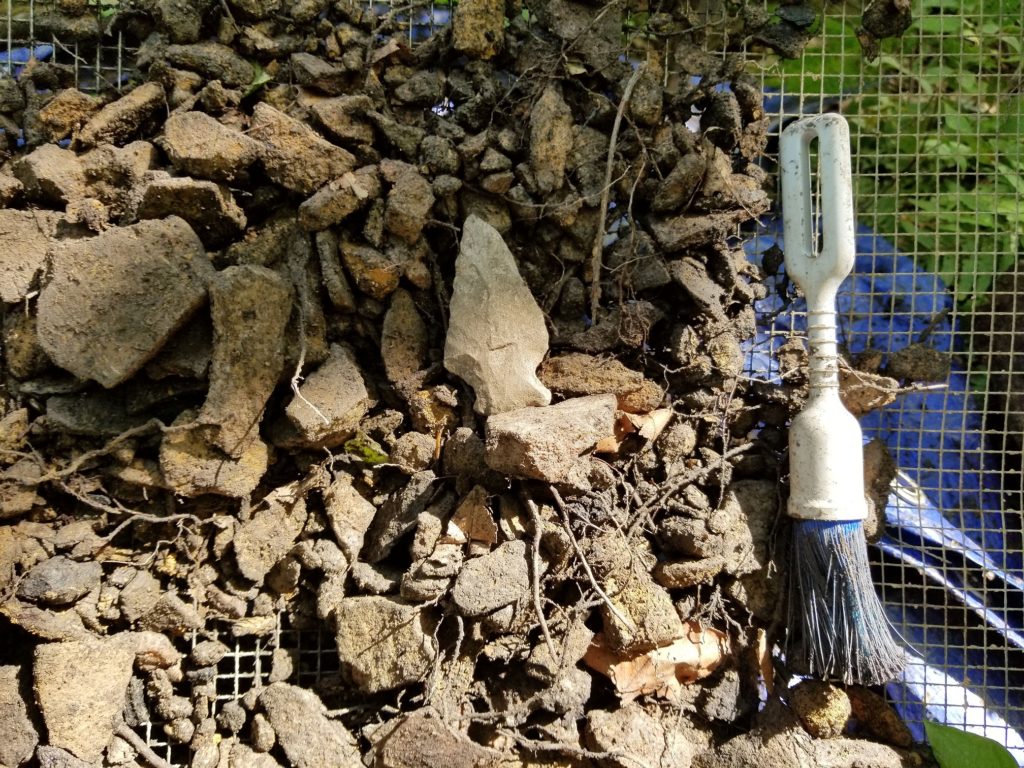
More work underway
“Alpenglow Rockshelter” is now a reality awaiting a university looking for a field school, or students in need of a thesis, or perhaps the membership of our local SPA Chapter.
I believe units will be opening this coming spring. Perhaps the whole length of this 50 meter overhang will eventually be studied, or the other 75 meters on the eastern slope opposite the vernal pool.
On a recent site visit, and sensing a connection with the Council Rocks ceremonial site, PA SHPO’s Noel Strattan commented that this valley might just have been Motel 6 for the peoples moving along the many known Native American trails in this area and visiting the various resources on this mountain.
I see it as a gathering place for visiting nations: Lenape, Algonquin, etc. coming to visit their Iroquois, Muncy, and Shawnee neighbors to celebrate the change of seasons on this small mountain between two river basins.
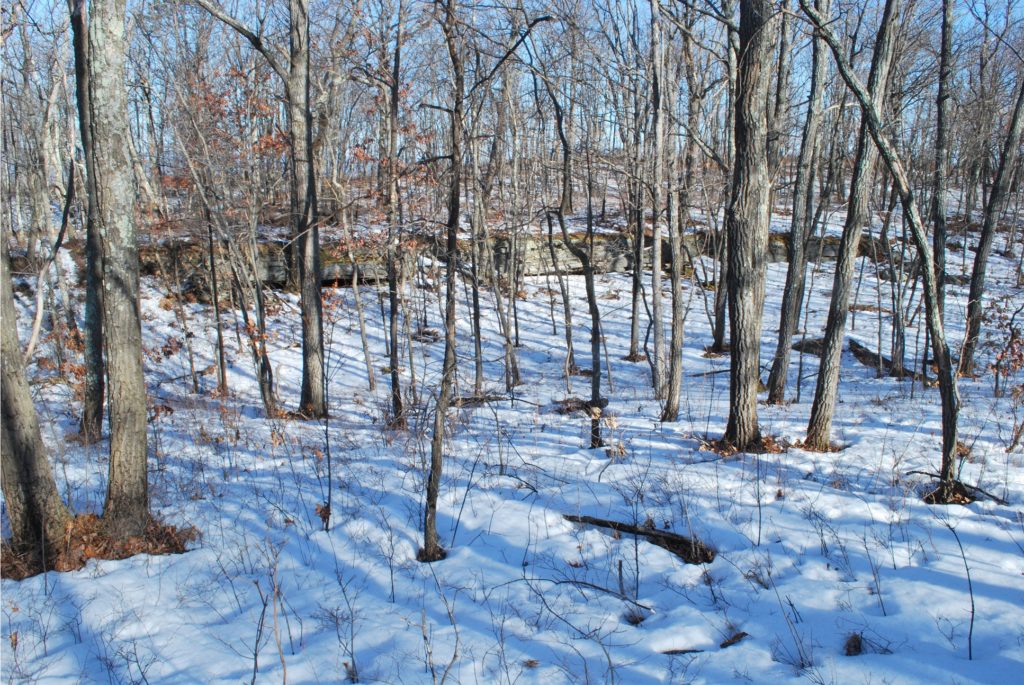
Follow Your Gut
Everything about this mountain has come to light by following gut feelings.
If there’s anything I’d like to impart to others, it’s to remember that every artifact you find was once used and held precious by someone who came before. Listen with your heart, feel the artifacts and feel the very space you’re working in.
Following this philosophy has led this avocational with no prior experience in archaeology to the discovery of two very significant sites with many more to come. Some are already in the works.
Time will tell who the “We” were in “We Were Here….”

Today’s Guest Contributor is Dave Gutkowski. Dave is an avocational archaeologist and principal researcher at the Council Rock Mountain project. His ongoing love of science and learning led him into the field of archaeology upon the discovery of sites referenced in this post. He is also a storage business owner, licensed massage therapist and Reiki master, retired postmaster, and amateur astronomer. Dave was born and raised in Pennsylvania and holds an associate degree in mechanical engineering from Penn State University.
Comment Policy
PHMC welcomes and encourages topic-related comments on this blog. PHMC reserves the right to remove comments that in PHMC’s discretion do not follow participation guidelines.
Commenters and Comments shall be related to the blog post topic and respectful of others who use this site.
Commenters and Comments shall not: use language that is offensive, inflammatory or provocative (this includes, but is not limited to, using profanity, obscene, or vulgar comments); disparage other commenters or people; condone illegal activity; identify the location of known or suspected archeological sites; post personal information in comments such as addresses, phone numbers, e-mail addresses or other contact details, which may relate to you or other individuals; impersonate or falsely claim to represent a person or an organization; make any commercial endorsement or promotion of any product, service or publication.
If you would like to comment on other topics not related to this blog post but related to PHMC, please fill out the PHMC Contact Us Form.
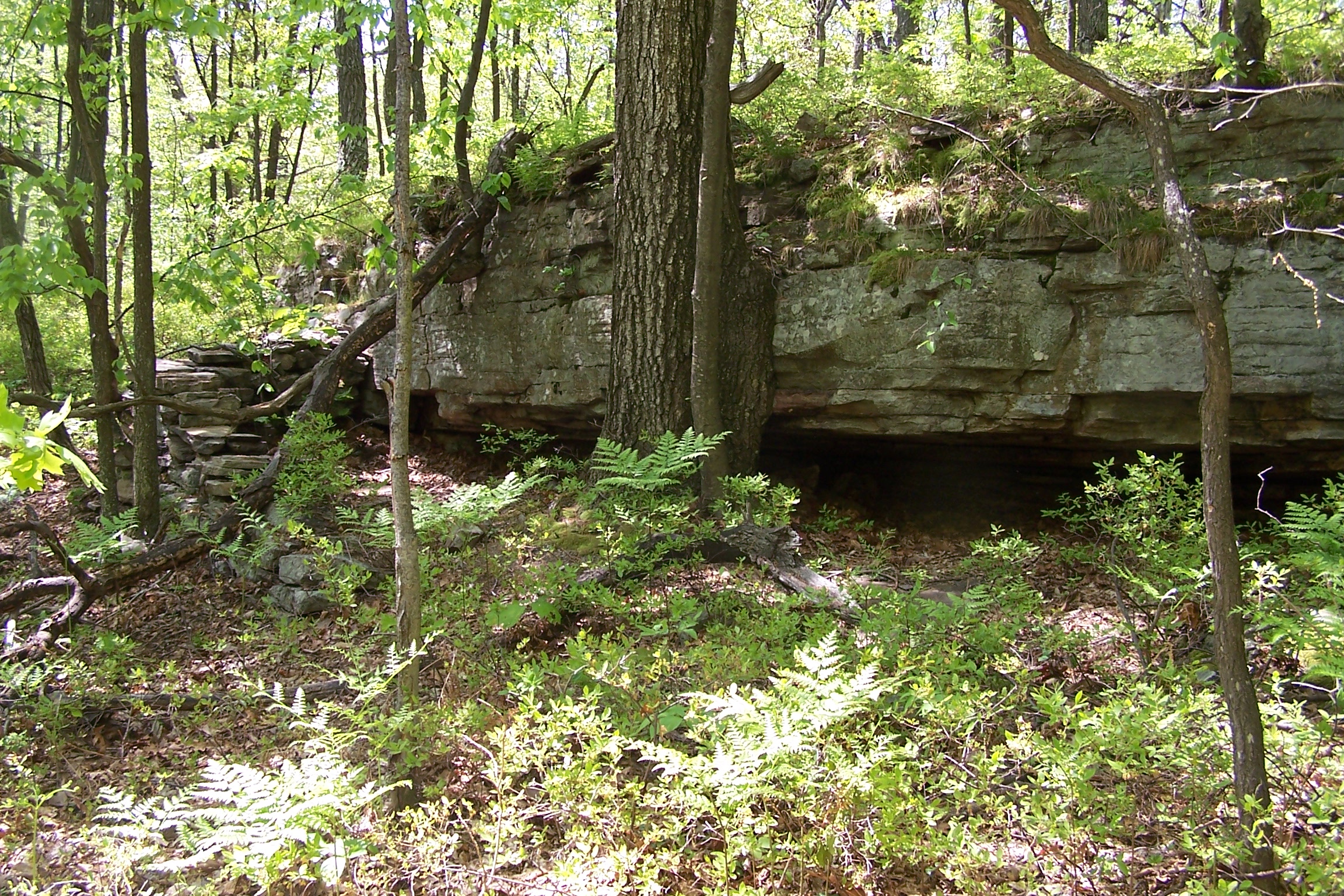
Interesting article. Mr. Gutkowski seems to be thorough in his research and investigations.
I liked the story of how the site was named.
Beautiful and magical place. Thank you Dave (and Carla) for sharing it’s magic!
Enjoyed the article. Presented his findings in a very interesting and fun story. As a history buff, I could fully relate to his joy in finding artifacts, following nature and more importantly trusting his gut. Hope to visit the site someday.
I feel honored and blessed to be part of this ongoing, magical journey! I’ve watched Dave grow and develop his skills in this field for 5 years now. He’s stretched and gone beyond all limitations within the field, and I am inspired by his audacious determination and hard work. Also, I have learned a lot by observing him, attending conferences, and aiding him in the field. I am very much in tune with nature, and the voices therein. To be the one to have found the crow, to have carried its body, so that its spirit could be carried even further, is an indescribable blessing. Sending a huge congratulations to my life partner, Dave for following his passions endlessly. Thank you for the inspiration to pursue all my dreams – to listen. So happy to be with you!! So excited to see what’s to come!
Dave, what a great discovery! I remember as a kid going to the museum in Wilkes-Barre and seeing the model of Elizabeth rock where Native Americans fought some of the first explorers of N E P a. That were captured. It was Called Queen Eluzabeths rock named after one of the female leaders of the Shawnee clan.. Where abouts is this located?
Hi Patrick!
My apologies for taking so long to reply. We’ve been doing Lidar and GPR work at the site even during the pandemic. I’ve had my hands full and didn’t keep up with this post. Just got led back to it because the band for who’s music the rockshelter was named posted the news on their website. All of a sudden my web and email traffic skyrocketed! So I’m back on and saw your message.
The rockshelter’s location is being held confidential from the public for protection, but I’d be happy to arrange to take you there if you like. I don’t think I can leave my email or phone # here. Just look my name up on facebook and message or friend me there and we’ll connect. 🙂
Dave,
I am intrigued by your article. One of the pictures resembles a rock shelter located at Frances Slocum State Park. I also wanted to mention the area near my home in Berks county has several sites suspected of being ancient Native American sites. It is a fascinating part of our history. Thanks for your work!
Thank you Lindsay !!
And as in my above message to Patrick, my apologies for the delay in getting back to you! Life’s been busy, even during quarantine times 🙂
I haven’t been to the shelter at Frances Slocum but I’m familiar with it. Maybe I should check it out. Thanks for the nudge 🙂
I’ve been following news of some work, possibly in the Berks County area by an organization called NEARA. They’ve dug beneath what were supposedly colonial stone constructions and using OSL (optically stimulated luminescence) techniques dated the construction to around 500 a.d. !! Very interesting stuff for sure!
And you’re welcome 🙂 I LOVE what I’m doing! It gives a whole lot of meaning to my life. So thanks!
Loved reading this! Alpenglow is a beautiful name, and it looks like it has a fascinating history. Great job!
Thanks Laura !!
I’m glad you enjoyed it. Thanks for the feedback. In working with Hannah at the SHPO I’m thrilled that other academics are also opening up to the possibility of significant constructions prior to the arrival of Europeans. Even more I’m happy to find more people opening up to listening to the still voice within, following their hearts to connect with the sites and ancestral people in a way we can’t yet fully understand. I don’t know how it works. It just does 🙂
And as for the Alpenglow name… the band Nightwish finally became aware of the rockshelter’s official registration and posted the news on their website! My email and internet traffic went through the roof ! I’m glad that they too get the connection through their music 🙂
Dave,
Love your article and your passion for investigating and researching the mountain. I am pleased to provide the 3D LiDAR scanning for you and love the way it is supporting your work. This digital modeling allows you to see your mountain like never before with eye-opening revelations. This combined with the below ground GPR investigations will provide new insights. And, as more research identifies new findings and confirms existing finding more peoplpe and allied professionals with kindred spirits will support your work. I look forward to future visits with you and Carla as your work moves forward.